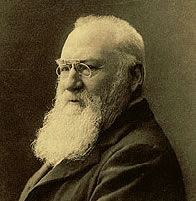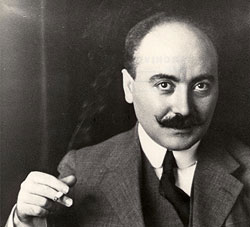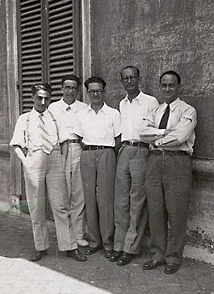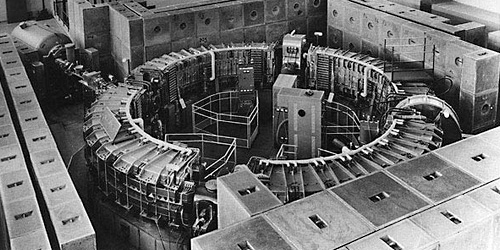Historical Facts
| The Institute of Physics of the University of Rome La Sapienza has gone through a period of transformation since the Unification of Italy. Changes started in 1872 when Pietro Blaserna was called to hold the Chair of Experimental Physics and was also appointed director of the Institute. In 1881 the Institute was located in Via Panisperna, in a new structure, mostly designed by Blaserna himself. The construction was innovative in Italy for its modern conception and distribution of rooms, for research laboratories equipment and teaching facilities. |
 |
|
 |
In 1918 Orso Mario Corbino (Senator of the Kingdom and Minister of Education) was appointed Director of the Institute. Corbino was another key figure in helping the growth of physics as a well-defined discipline, in favoring the diffusion of the "new physics" in Italy, and for the special support that he gave to the research work of Enrico Fermi and his group. |
|
|
In 1926 Enrico Fermi (teaching activity) was assigned the first Chair of Theoretical Physics in Rome. The teaching of this subject had been introduced in Italy by Corbino. A group of young scientists: (Edoardo Amaldi, Emilio Segre, Franco Rasetti, Ettore Majorana joined Fermi to form the so-called "Via Panisperna group". Rasetti, Segre, Amaldi and the chemist Oscar D'Agostino, led by Fermi, discovered the neutron-induced radioactivity in 1934. In the same year Bruno Pontecorvo joined the group and started a research on the properties of slow neutrons. Since 1936 the Physical Institute (which in 1937 was named after "Guglielmo Marconi", the great scientist, inventor and Nobel Prize Laureate in Physics 1909) has been located in the Physics Department In 1938 Fermi was awarded the Nobel Prize for Physics. The year also marks "brain drain" from Italy: Fermi, and later, Segrè, Pontecorvo and Rasetti were forced to leave the country. |
 |
To superintend the Institute of Physics of Rome remained Amaldi together with the researchers Gilberto Bernardini, Bruno Ferrretti, Mario Ageno, and the young graduates Oreste Piccioni and Marcello Conversi, Giancarlo Wick and BN Cacciapuoti. In 1946, Conversi, Ettore Pancini and Piccioni carried out in Rome an experiment that marked the beginning of high energy physics showing that the penetrating cosmic ray particles (now called "muons") were not the particles hypotized by Yukawa. In 1951 the National Institute for Nuclear Physics (INFN) was founded and Amaldi was the head of the Institute from 1960 to 1965. Amaldi was appointed Secretary General of CERN at the first Council Session held in Paris in May 1952. In 1959 under the direction of Giorgio Salvini, the 1100 MeV Electrosynchrotron was completed in Frascati (near Rome).
 From an original idea of Bruno Touschek, professor at the Institute of Physics, the first electron-positron collider ADA was realized in Frascati in 1961. All modern elementary particles storage rings, among which LEP, derive from this first prototype . In 1962 Amaldi promoted the creation of the European Space Research Organization (ESRO), from which the ESA (European Space Agency) later originated. Many other outstanding scientists in our Department achieved great results for the development of Physics through the years and occupied important positions in various research Institutes. Among these Giorgio Salvini, the first Director of the National Laboratories of Frascati, INFN President from 1966 to 1970 and Minister of University and Scientific Research in 1995, Nicola Cabibbo, President of the INFN from 1983 to 1993 and later President of the ENEA, Luciano Maiani, INFN president from 1993 to 1999 and then General Director of CERN, Giorgio Parisi, one of the youngest members appointed to the Accademia Nazionale dei Lincei, Giorgio Fiocco, President of the Italian Space Agency from 1994 through 1995; Miguel A. Virasoro, Director of the International Center of Theoretical Physics of Trieste from 1995 to 2002.
From an original idea of Bruno Touschek, professor at the Institute of Physics, the first electron-positron collider ADA was realized in Frascati in 1961. All modern elementary particles storage rings, among which LEP, derive from this first prototype . In 1962 Amaldi promoted the creation of the European Space Research Organization (ESRO), from which the ESA (European Space Agency) later originated. Many other outstanding scientists in our Department achieved great results for the development of Physics through the years and occupied important positions in various research Institutes. Among these Giorgio Salvini, the first Director of the National Laboratories of Frascati, INFN President from 1966 to 1970 and Minister of University and Scientific Research in 1995, Nicola Cabibbo, President of the INFN from 1983 to 1993 and later President of the ENEA, Luciano Maiani, INFN president from 1993 to 1999 and then General Director of CERN, Giorgio Parisi, one of the youngest members appointed to the Accademia Nazionale dei Lincei, Giorgio Fiocco, President of the Italian Space Agency from 1994 through 1995; Miguel A. Virasoro, Director of the International Center of Theoretical Physics of Trieste from 1995 to 2002.
